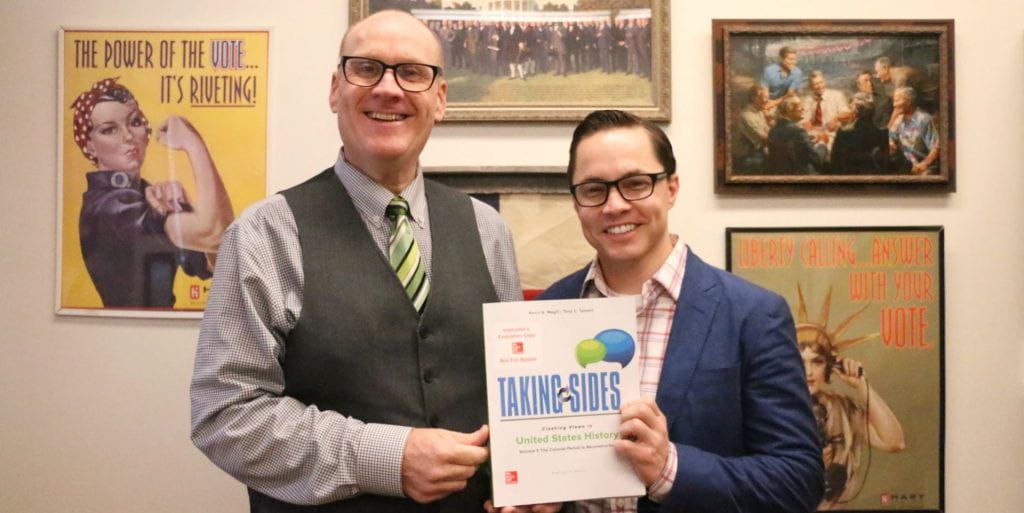For 35 years, the popular McGraw-Hill historical text series Taking Sides: Clashing Views in U.S. History has been edited and authored by former history professors. Now the baton has been passed to Baylor School of Education faculty Dr. Tony L. Talbert and Dr. Kevin R. Magill. The duo’s background in social studies and pedagogy brands their writing of the 18th edition with a unique edge of cultural and social consideration while consciously reaching for the reader’s attention. Since 1985, the most successful companion classroom resource has analyzed historical nuances between facts to provide a well-rounded perspective for students and educators.
Flip through a traditional American history textbook and you will find the expected – a linear progression of facts, drawn from primary resources, about what happened before and after the Civil War. Every event from the American Revolution to the Civil Rights movement is covered and drilled down to the basics. But Magill and Talbert do not find the past so simply compartmentalized.
Talbert said, “Not everyone agrees, so we want to know how people argue each topic to show the complexity of the issue. That’s what social studies is. It is not traditional historiography. It problematizes the moment. It is hard to argue yes or no when it is really a bifurcated response. We own that up front.”
Since McGraw-Hill released the first pre-Civil War volume in February, the Baylor duo has refined their research process. Talbert says their social studies approach to each issue is like laying different lenses over each historical event. One of their basic integrated approaches is PERSIA (political, economic, religious, social, intellectual, artistic), that considers the outside factors and conditions that set the stage for history.
Magill said, “If you individually asked every student what was done in class yesterday, they each would create a narrative, and there would absolutely be differences. There are multiple truths. Many sources can say they saw this or that, while the historical evidence says otherwise. We can make good assumptions and trust certain sources, but there may be no truth in some narratives. Each is a subjective truth and interpretation, so we learn what we can.”
Talbert said that, as he worked on the first volume, he found importance in making the content relevant to present American culture. While writing about the doubt surrounding Alexander Hamilton’s economic genius, he weaved in the world-famous musical Hamilton, asking the reader if what society generally concedes to is what becomes the ultimate truth.
Magill said, “We want to know the long-term effect of how an event informed us, the way we act socially because of it, and the way it changes who we are as citizens today. We choose topics that we want to pull back the curtain on, point out how we understand certain things in our current society, and then take a look at more than one history that suggests differently.”
Talbert and Magill said that through their social studies foundation, they want to humanize history. They find voices from different genders and people of color in bookshelves, doctoral programs, and universities across the world to include in their research. Talbert notes a source does not necessarily need to be born and cultured in the U.S. to have valid opinions on the country.
Talbert and Magill are eager to explore a sweeping global outlook of the United States that gives students a chance to create and question what they know as fact. Their second volume is proving to be less difficult as Talbert and Magill polish their collaboration process. They are writing it with a single imposing question: If the U.S. is leading this century, who is the next world power?
“We’re not saying our provided documents are the full authority, but what we would like to do is help provide another perspective, so students can look into the issue in differently framed ways and want to understand even more,” Magill said.
—By Cameron Bocanegra
For more news from Baylor School of Education, visit the Instant Impact home page.
For media inquiries, please contact Meg_Cullar@baylor.edu / (254) 710-6435.
ABOUT BAYLOR SCHOOL OF EDUCATION
For more than 100 years Baylor educators have carried the mission and practices of the School of Education to classrooms and beyond as teachers, superintendents, psychologists, health education professionals, academics/scholars and more. With more than 50 full-time faculty members, the school’s growing research portfolio complements its long-standing commitment to excellence in teaching and student mentoring. Baylor’s undergraduate program in teacher education has earned national distinction for innovative partnerships with local schools that provide future teachers deep clinical preparation, while graduate programs culminating in both the Ed.D. and Ph.D. prepare outstanding leaders, teachers and clinicians through an intentional blend of theory and practice.
ABOUT BAYLOR UNIVERSITY
Baylor University is a private Christian University and a nationally ranked research institution. The University provides a vibrant campus community for more than 16,000 students by blending interdisciplinary research with an international reputation for educational excellence and a faculty commitment to teaching and scholarship. Chartered in 1845 by the Republic of Texas through the efforts of Baptist pioneers, Baylor is the oldest continually operating University in Texas. Located in Waco, Baylor welcomes students from all 50 states and more than 80 countries to study a broad range of degrees among its 12 nationally recognized academic divisions.

